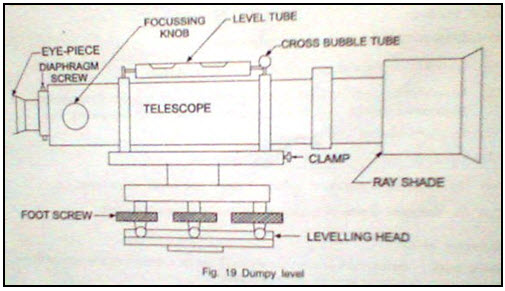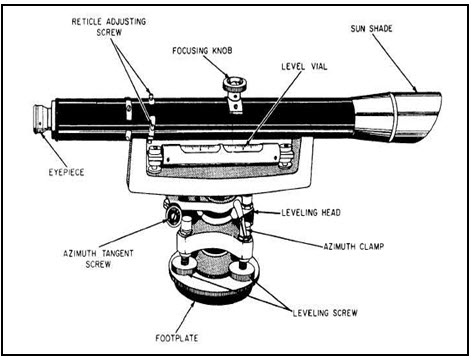Site pages
Current course
Participants
General
MODULE 1.
MODULE 2.
MODULE 3.
MODULE 4.
MODULE 5.
MODULE 6.
MODULE 7.
MODULE 8.
MODULE 9.
26 April - 2 May
Lesson 9. Levelling- description of level instruments
The art of determining relative altitudes of points on the surface of the earth of beneath the surface of earth is called LEVELLING.
For execution of Engineering Projects it is very necessary to determine elevations of different points along the alignment of proposed project.
Other applications are :
i) Taking rail levels existing before track renewals to finalise final rail level profile including vertical curves.
ii) Initial ground levels for earthwork calculations.
iii) Levels for measurement of earthwork.
iv) Measurement of ballast etc.
Terms used in Levelling –
a) DATUM – or Datum plane is an arbitrarily assumed level surface or line with reference to which level of other line or surface are calculated.
b) REDUCED LEVEL (RL) – Height or depth of a point above or below the assumed datum is called Reduced level.
c) BENCH MARK – (BM) – B.M. is a fixed reference point of known elevation. It may be of the following types.
i) GTS Bench mark (Geodetic Triangulation Survey) :
These Bench marks are established by national agency like Survey of India. They are established with highest precision. Their position and elevation above MSL is given in a special catalogue known as GTS Maps ( 100 km. interval).
ii) Permanent Bench Mark : They are fixed points of reference establish with reference to GTS Bench mark (10 km. interval).
iii) Arbitrary Bench mark : These are reference points whose elevations are arbitrarily assumed. In most of Engineering projects, the difference in elevation is more important than their reduced levels with reference to MSL as given in a special catalogue known as GTS Maps ( 100 Km. interval).
d) Mean Sea Level (M.S.L.) : M.S.L. is obtained by making hourly observations of the tides at any place over a period of 19 years. MSL adopted by Survey of India is now Bombay which was Karachi earlier.
e) Level Surface : The surface which is parallel to the mean sphereoidal surface of the earth is known as level surface.
f) Line of Collimation : It is the line joining the intersection of the cross hair and the optical center of the objective and its extensions, it is also called line of sight or collimation.
g) Height of Instrument (HI) : The elevation of the line of sight with respect to assumed datum is known as height of Instrument(HI).
h) Back sight : (B.S.) - The first sight taken on a levelling staff held at a point of known elevation. B.S. enables the surveyor to obtain HI +sight i.e. Height of Instrument or line of sight.
i) Fore Sight : (F.S.) – It is the last staff reading taken from a setting of the level. It is also termed as minus sight.
Fore sight is the sight taken on a levelling staff held at a point of unknown elevation to ascertain the amount by which the point is above or below the line of sight. This is also called minus sight as the foresight reading is always subtracted from height of Instrument.
j) Change Point (CP) : The point on which both the foresight and back sight are taken during the operation of levelling is called change point.
k) Intermediate Sight (IS) :
The foresight taken on a levelling staff held at a point between two turning points, to determine the elevation of that point, is known as intermediate sight.
It may be noted that for one setting of a level, there will be only one back sight and one foresight but there can be any number of intermediate sights.
Type of Levelling Equipments:
i) Dumpy level
ii) Tilting level
iii) Automatic level
iv) Digital Auto level
Dumpy level : It is simple compact and stable. The telescope is rigidly fixed to its support therefore cannot be rotated about its longitudinal axis. A long bubble tube is attached to the top of telescope. Dumpy literally means short and thick.
Tilting level : It consists of a telescope attached with a level tube which can be tilted within few degrees in vertical plane by a tilting screw. The main peculiarity of this level is that the vertical axis need not be truly vertical, since the line of collimation is not perpendicular to it. The line of collimation, is, however, made horizontal for each pointing of telescope by means of tilting screw. It is mainly designed for precise levelling work.
The Automatic level : Also termed as self aligning level. The fundamental difference between automatic and the classic spirit level is that in the former the line of sight is no longer levelled manually using a tubular spirit level, but is levelled automatically within a certain tilt range. This is achieved by compensator in the telescope.
DUMPY LEVEL
It is simple compact and stable. The telescope is rigidly fixed to its support therefore cannot be rotated about its longitudinal axis. A long bubble tube is attached to the top of telescope. Dumpy literally means short and thick.

Fig 9.1 Dumpy level

Fig 9.2 Parts of Dumpy level
The different parts of levelling instrument are,
(a)Telescope
(b) Eye-piece
(c) focussing knob
(d) level tube
(e) cross bubble
(f) foot screws
(g) levelling head
(h) diaphragm
(i) ray shade
Basic components of level :
1. Telescope – to provide a line of sight
2. Level Tube – to make line of sight horizontal
3. Levelling head – to bring the bubble of tube level at the centre of its run.
4. Tripod – to support the above three parts of the level.
TELESCOPE : Telescope is an optical instrument used for magnifying and viewing the images of distant objects. It consists of two lenses. The lens fitted near the eye is called the eye piece and the other fitted at the end near to the object is called the objective lens. The objective provides a real inverted image infront of the eye piece at a distance lesser than its focal distance.
Two essential conditions are involved. :
i) The real image of the object, must be formed.
ii) the plane of image must coincide with that of cross hairs.
Focusing of Telescope : The operation of obtaining a clear image of the object in the plane of cross hairs is known as focusing.
1. Diaphram : A frame carrying cross hairs usually made of either silk thread or platinum wire and placed at the plane at which vertical image of the object is formed by the objective. Vertical hair of the diaphram enables the surveyor to check the verticality of levelling staff whereas horizontal hairs are used to read the staff graduations.
2. Level Tube : Also known as Bubble Tube consists of a glass tube placed in a brass tube which is sealed with plaster of paris. The whole of the interior surface or the upper half is accurately ground so that its longitudinal section, is an arc of a circle. Level tube is filled with either or alcohol, the remaining space is occupied by an air bubble. The centre of air bubble always rest at the highest point of the tube. Outer surface of the bubble tube is graduated in both the directions from the centre. The line tangential to the circular are at its highest point i.e. the middle of tube is called the axis of bubble tube. When the bubble is central the axis of bubble becomes Horizontal. The level tube is attached on the top of Telescope by means of capstan headed nuts.
3. Levelling head : Levelling head generally consists of two parallel plates with 3 foot screws. Upper plate is known as Tribrach and lower plate is trivet which can be screwed on to the tripod. Levelling head has to perform three distinct functions :
i) to support the telescope
ii) to attach the level to the tripod
iii) to provide a means for level (foot screws)
Adjustments of level :
(i) Temporarily Adjustments – adjustments which are made for every setting of a level.
(ii) Permanent adjustments- required if some error is there in instrument.
(i) Temporary Adjustments : includes
a) setting up the level
b) levelling up
c) elimination of parallax
a) Setting up the level : This operation includes fixing the instrument on the tripod and also approximate levelling by leg adjustment.
b) Levelling up : Accurate levelling is done with the help of foot screws and by using plate levels. The object of levelling up the instrument is to make its vertical axis truly vertical.
c) Elimination of parallax : If the image formed by the objective does not lie in the plane of the cross hairs, there will be a shift in the image due to shift of the eye. Such displacement of image is termed as parallax. Parallax is removed in two stages.
1) Focusing the eye for distinct vision of cross hairs.
2) Focusing the objective so that image is formed in the plane of cross hairs.
Levelling staff
It is an important accessory used with levelling instrument at the time of conducting levelling survey. Reading is taken on the levelling staff held properly at the point concerned by viewing through the telescope of the levelling instrument. Usually 4 m levelling staff may be used of folding type or telescopic type. Aluminium levelling staff foldable at every metre length has also came to the market. The levelling staff consists of three pieces. The topmost one slides into the middle one and the middle portion slides into the bottom one. When the staff is fully pulled, it will read exactly 40 decimeters (4m) from the bottom shoe.
Graduation in levelling staff:
-
Every metre length is divided into 200 divisions.
-
The divisions are painted in black and white alternately of thickness 5 mm each.
-
The graduation figures are marked at every decimeter length.
-
The number indicating metre is in red and the decimeter number is in black.
-
Thus, a graduation figure of 24 indicates 2 metres and 4 decimeters.
-
The graduation are made continuously one above the other in the same line.
-
The division lines should be parallel to the base of the bottom shoe and perpendicular to the length of the staff.
-
The edges of the division lines should be straight sharply defined.
-
They should be clear and made distinctly visible by properly contrasting.
-
The graduation colour paints used should not crack or blister when exposed to adverse or atmospheric conditions.